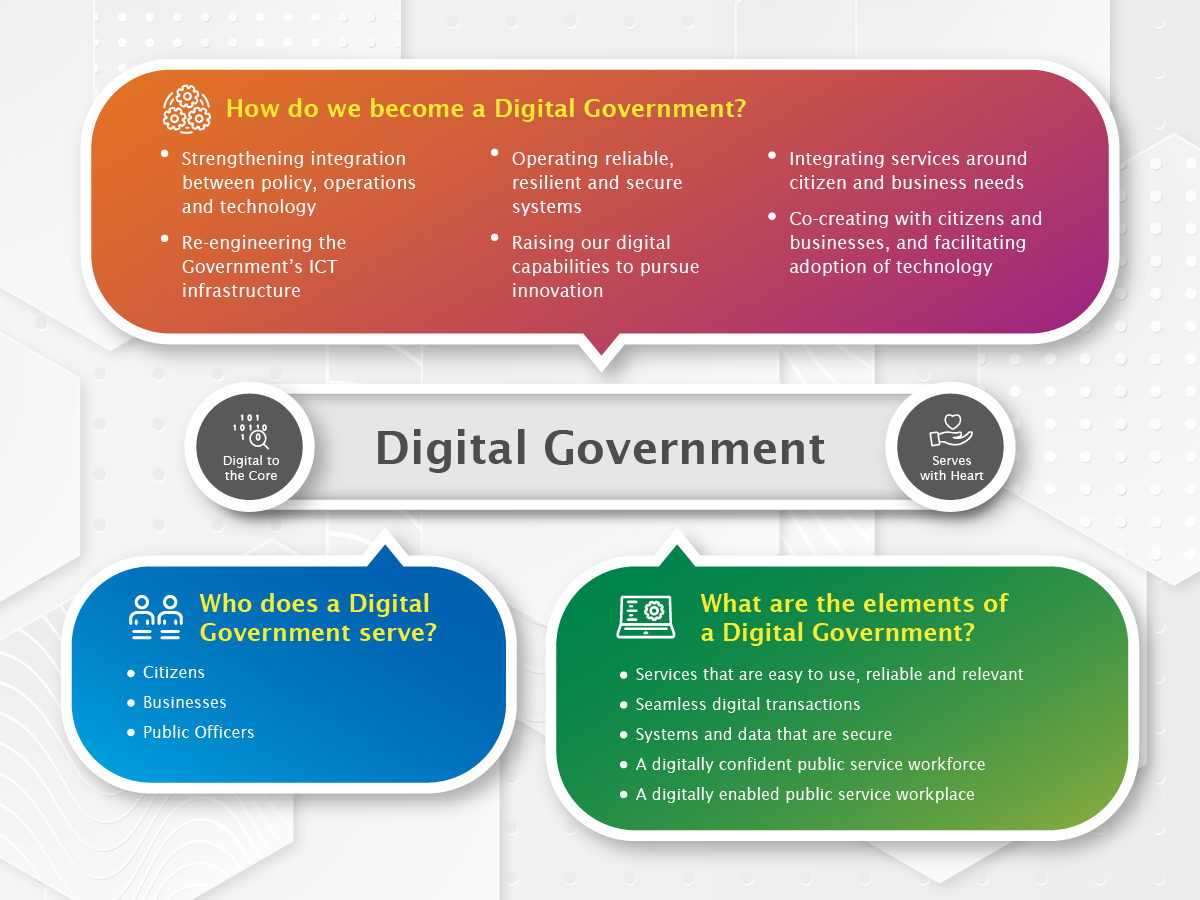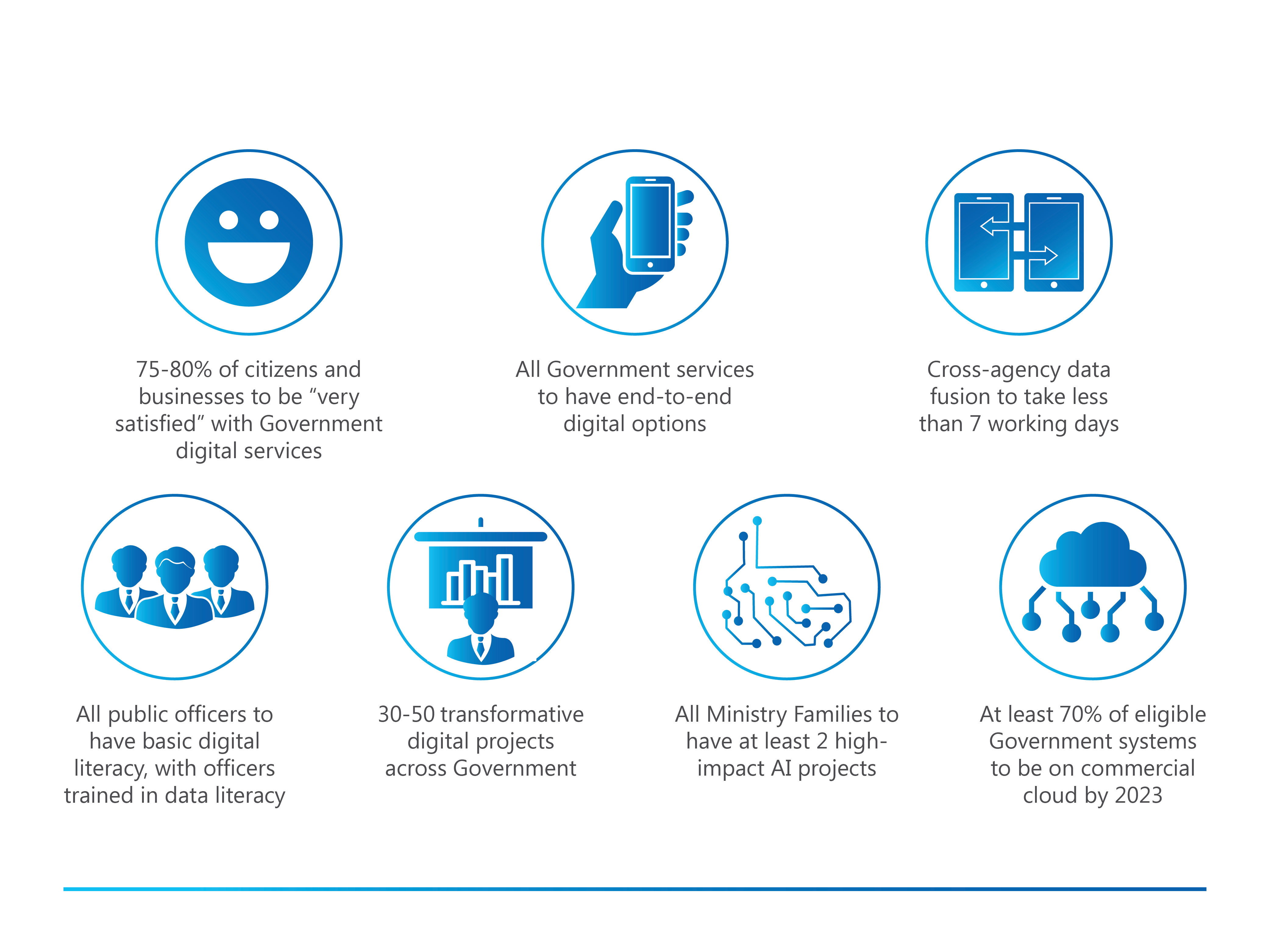Digital Government Blueprint
Digitalisation is a key pillar of the Government’s public service transformation efforts. The Digital Government Blueprint (DGB) is a statement of the Government’s ambition to better leverage data and harness new technologies, and to drive broader efforts to build a digital economy and digital society, in support of Smart Nation.
Our vision is to create a Government that is “Digital to the Core, and Serves with Heart”. A Digital Government will be able to build stakeholder-centric services that cater to citizens’ and businesses’ needs. Transacting with a Digital Government will be easy, seamless and secure. Our public officers will be able to continually upskill themselves, adapt to new challenges and work more effectively across agencies as well as with our citizens and businesses.
Two years after the launch of the DGB, the Government has introduced new policies and initiatives. COVID-19 has also reaffirmed our emphasis on capability building, and compelled different parts of the Government to accelerate the use of data and of technology to offer digital services that minimise physical contact, and to use technology and digital tools to keep us safe.
The DGB has been updated to accurately reflect the current plans and to push for more ambitious goals to pursue deeper and more extensive digitalisation within the Government. New examples are included to better explain the latest efforts and benefits of Digital Government. The refresh is in line with the approach to improve the blueprint iteratively.
The key changes made to the DGB include:
-
Elaboration on the DGB vision of “Digital to the core” and “Serves with heart”. A “digital to the core” framework has been developed to describe how the Government is developing and measuring itself towards this vision. There is a greater emphasis on “Serves with heart” to explain how the use of digital technologies is to help the Government achieve its main purpose of serving citizens better and building trust.
-
Updated DGB strategies that stresses greater importance on user centricity and co-creation, improving how we work as digital organisations and harnessing new technology including Artificial Intelligence.
- New and updated KPIs.
- New KPI: at least 70% of eligible Government systems to be on commercial cloud by 2023
- Update existing KPI: Time required to fuse and share core data for cross-agency projects to be no more than 7 working days
- The future direction for Digital Government, as at 2020 and in light of COVID-19. A new section has been added to signal the future direction and the steps that agencies need to undertake to progress towards being digital organisations, which requires deeper changes in organisational policy, structure, and culture.
Key Highlights of the Progress of DGB KPIs as of end-2019
- 86% of citizens and 77% of businesses reported that they are “very” or “extremely” satisfied (at least 5 on a 6-point scale) with Government digital services, against the DGB target of 75-80%. These are the best results since the survey started in 2012. Both results also improved significantly, by 8%, compared to 2018.
- To date, 95% of transactions (by volume) are completed digitally from end-to-end, meeting the target of 90-95%.
- We have met the target for number of officers trained in data analytics and data science and will review a new KPI.
- All 20 Ministries have submitted plans to use Artificial Intelligence.

Here is how the DGB will benefit you:
- Electronic payment and digital signature options for 100% of Government services
- Intuitive, accessible and easy-to-use digital services
- Greater confidence in your data as digital services infrastructure continues to be fortified
- More digital services like LifeSG and GoBusiness built around your needs.
Future Plans
The DGB is a testament of Singapore’s ambition to leverage data and new technologies to a digital economy and digital society in building a Smart Nation.
Based on the DGB, GovTech plans to achieve the following goals by 2023:

[1] Excludes services or individuals where the KPI cannot be met for valid reasons. These reasons can include legislative reasons, or that certain segments of our population (e.g. the elderly or persons with disabilities) are unable to have access to or use digital tools.
[2] Government systems qualify if data classification requirements allow them to be moved to cloud.
Read about the DGB here:
https://www.tech.gov.sg/digital-government-blueprint/
